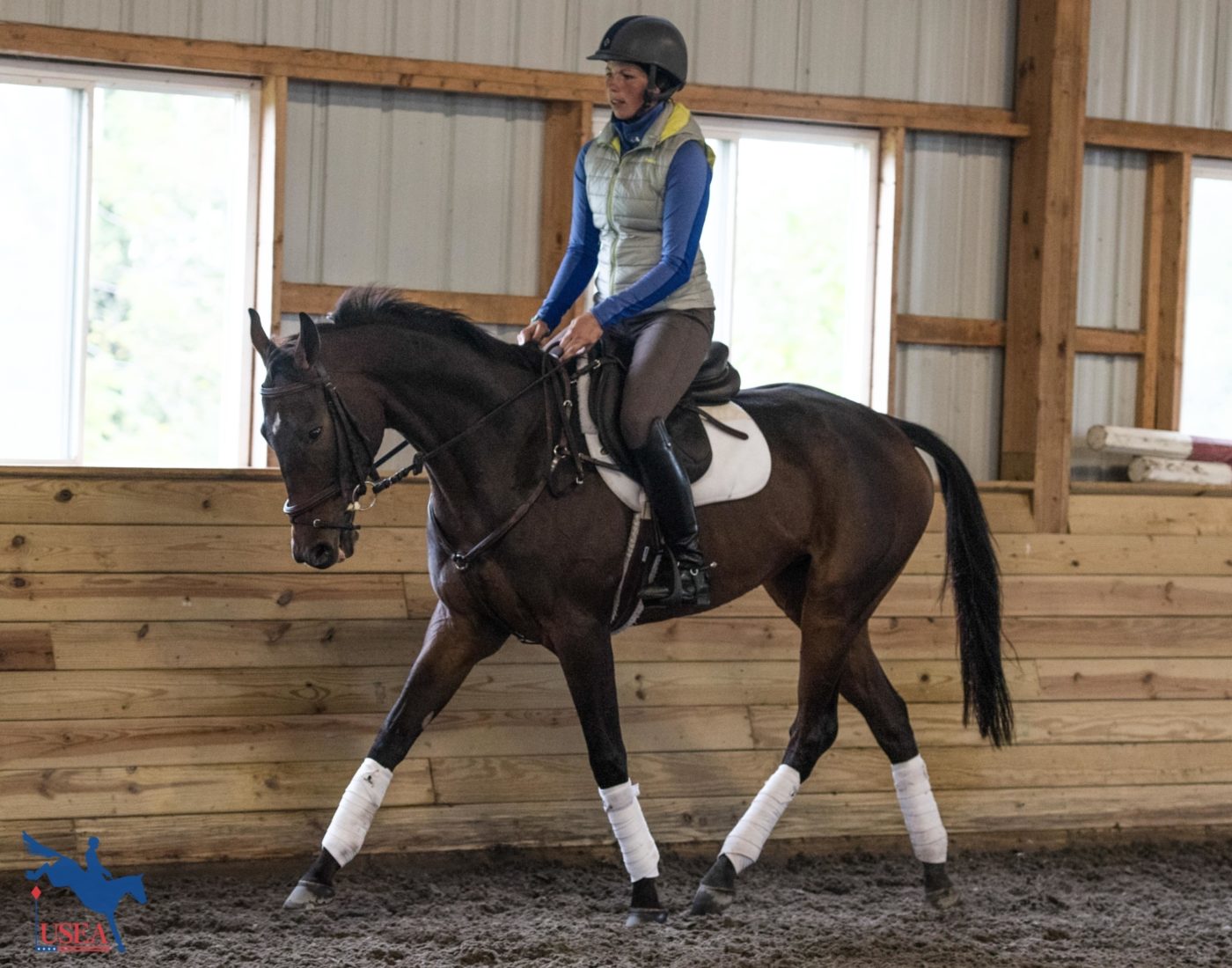Renew Your USEA Membership for the 2023 Season Today LEARN MORE

The Young and Future Event Horse article series is being provided through a partnership between Mythic Landing Enterprises, LLC. and the USEA.
As the cold weather seems to linger on, Lauren Ferguson provides us with more exercises you can work on with your young eventer through the winter, along with working on your own fitness. Look at the wintertime as an opportunity to really enhance your skills as a rider and allow yourself time to get to the basics with your horse so when the competition season comes around, you’re confident and ready.
As Ferguson mentioned in part one of this series, taking the time to focus on yourself as a rider is extremely important. It’s so easy for us to get wrapped up in what our horses are doing that we forget to ride correctly, but rather adapt to our horse’s bad habits. Ferguson encourages riders to take a day and ride with a bridge in your reins. This allows you to test how genuine your horse’s connection really is. Are you faking your horse’s frame by pulling their head down and never closing your leg? This exercise will certainly tell you!
Ferguson notes, “Make sure your elbows are out in front of your hips with your reins fairly short and in a bridge. As you go around the ring in all three gaits, you should find that you need a lot of leg pressure to ask your horse to push from their hind end, soften through their back and come up to your hand. You’re looking for a connection in both reins that comes solely from your seat and leg, not a pulling rein aide. This is a great, simple exercise that allows you to check in and be honest with yourself!”
If you find that it’s difficult to get a true connection, keep a mental note. You may be pulling and “faking” the connection and frame when you’re holding one rein in each hand. Spend lots of time over the winter working on this exact exercise on your flat days, your warm-up before your jumping lesson, and even when you’re out for a hack.
Working on your horse’s fitness can be quite difficult with less than ideal footing conditions. Ferguson mentions that you don’t need to be doing trot and canter sets for your horse to keep up with their fitness.
“Long walks are one of the best ways to keep and increase your horse’s fitness through the winter. When you’re out on a hack, have your horse walking with the step that they have when they come off cross-country and make sure they’re round and really pushing from their hind end. If you can do that once a week for 45 minutes to an hour when weather permits, you’ll have one fit horse,” Ferguson continues.
The majority of professional riders usually take their operation south for the winter, at least for a few weeks, so if your trainer is leaving you for a significant amount of time, Ferguson suggests this simple, yet challenging jumping exercise that you can work on at home on your own.
Trotting fences is always a surprisingly difficult exercise, one that requires discipline from the riders position and patience from the horse. Ferguson explains how she recently attended a clinic with four-star event rider and Olympian Stephen Bradley and worked on this particular exercise that she now regularly works into her weekly routine and incorporates into all her lessons with her students.
To start, set up one crossrail to a crossrail oxer 60’ apart with a placing rail in front of and behind each jump. The placing rails should be set 9’ before and after the first crossrail, and then 9’ before the crossrail oxer and 10’ after the crossrail oxer. The exercise is to simply trot in, jump the first crossrail and trot the second crossrail oxer. Most horses will canter away from the first crossrail, so it’s up to the rider to focus on their position by stretching up tall upon landing, and closing their leg to get a balanced downward transition in order to nicely trot out over the second jump. This exercise is also super for practicing straightness while keeping your horse in front of your aides, along with riding forward into a downward transition. This is very helpful for asking your horse to sit down and push from their hind-end, which in turn helps them use themselves appropriately in the air.
If after working through this exercise, you feel like your horse is either rushing or not staying in front of your leg, try sitting the trot to the first fence to encourage your horse to keep the same rhythm. When you bring your horse back to the trot, stay in that sitting trot again all the way down to the base of the second jump.
Depending on you and your horse’s experience level, you can increase the difficulty of this exercise by making the jumps a bit taller, and the oxer wider. And once you’ve mastered the exercise at the trot, try it at the canter, working at keeping your horse’s rhythm exactly the same on the approach, take-off, landing, and in between of the two jumps.
Lauren Ferguson is an experienced three-star level eventer that enjoys bringing young and talented horses up through the levels, while still maintaining the goal of riding at the four-star level. Based out of Goshen, Kentucky, Lauren’s wide range of students thrive in her training program where her ultimate goal is to develop a confident, happy, and successful relationship between horse and rider. Lauren’s patient and systematic approach to teaching her students and bringing her young talent along allow her to be successful in the Future and Young Event Horse programs. To learn more about Ferguson and her program, please visit her website.